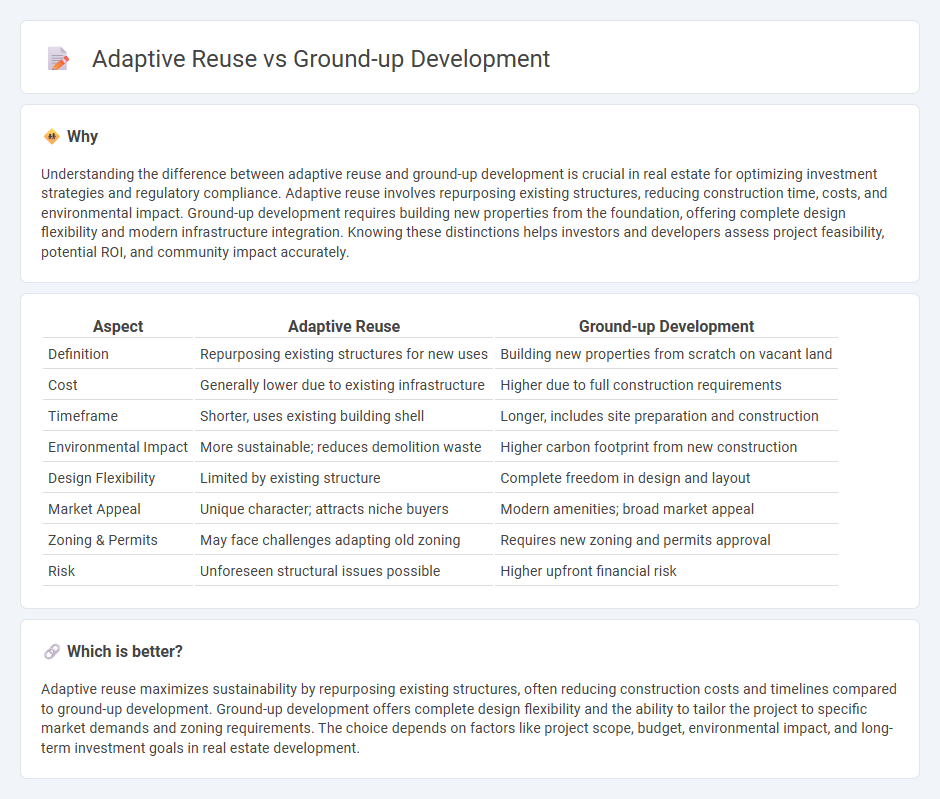
Adaptive reuse transforms existing structures into functional spaces, preserving historical value and reducing environmental impact, while ground-up development involves constructing new buildings from scratch, offering complete design flexibility and modern infrastructure. Both approaches address urban growth and sustainability but differ in cost, timeline, and resource utilization. Explore detailed comparisons to determine the best strategy for your real estate project.
Why it is important
Understanding the difference between adaptive reuse and ground-up development is crucial in real estate for optimizing investment strategies and regulatory compliance. Adaptive reuse involves repurposing existing structures, reducing construction time, costs, and environmental impact. Ground-up development requires building new properties from the foundation, offering complete design flexibility and modern infrastructure integration. Knowing these distinctions helps investors and developers assess project feasibility, potential ROI, and community impact accurately.
Comparison Table
| Aspect | Adaptive Reuse | Ground-up Development |
|---|---|---|
| Definition | Repurposing existing structures for new uses | Building new properties from scratch on vacant land |
| Cost | Generally lower due to existing infrastructure | Higher due to full construction requirements |
| Timeframe | Shorter, uses existing building shell | Longer, includes site preparation and construction |
| Environmental Impact | More sustainable; reduces demolition waste | Higher carbon footprint from new construction |
| Design Flexibility | Limited by existing structure | Complete freedom in design and layout |
| Market Appeal | Unique character; attracts niche buyers | Modern amenities; broad market appeal |
| Zoning & Permits | May face challenges adapting old zoning | Requires new zoning and permits approval |
| Risk | Unforeseen structural issues possible | Higher upfront financial risk |
Which is better?
Adaptive reuse maximizes sustainability by repurposing existing structures, often reducing construction costs and timelines compared to ground-up development. Ground-up development offers complete design flexibility and the ability to tailor the project to specific market demands and zoning requirements. The choice depends on factors like project scope, budget, environmental impact, and long-term investment goals in real estate development.
Connection
Adaptive reuse and ground-up development both address urban growth by transforming spaces to meet contemporary demands. Adaptive reuse converts existing buildings into new functions, preserving historical elements and reducing environmental impact, while ground-up development involves constructing entirely new structures optimized for current needs. Together, these approaches support sustainable urban planning by balancing preservation with innovation in real estate development.
Key Terms
Zoning Regulations
Zoning regulations critically influence the feasibility of ground-up development and adaptive reuse projects by determining allowable land use, building heights, densities, and setbacks. Ground-up development often requires strict compliance with current zoning codes, potentially limiting design flexibility, whereas adaptive reuse can benefit from variances or exemptions aimed at preserving historic structures or promoting sustainability. Explore more about how zoning impacts these development approaches and maximizes project potential.
Construction Costs
Ground-up development typically incurs higher construction costs due to extensive site preparation, foundational work, and new infrastructure installation, whereas adaptive reuse leverages existing structures, often reducing material expenses and labor time. However, adaptive reuse can also present unexpected costs related to structural retrofitting, code compliance, and hazardous material removal. Explore detailed cost comparisons and factors affecting construction budgets in both development approaches to make informed investment decisions.
Existing Structures
Adaptive reuse maximizes the value of existing structures by preserving architectural integrity and reducing construction waste, offering sustainable alternatives to ground-up development. Renovating historic buildings often improves energy efficiency and uses fewer resources compared to new construction, aligning with green building standards such as LEED certification. Explore the benefits and challenges of both approaches to optimize your development strategy.
Source and External Links
What is Ground-Up Development? Demystifying the Process for Businesses and Investors - Ground-up construction involves developing a property from scratch, either on raw land or by tearing down existing structures and building anew.
What is Ground Up Development? - Ground-up developers convert unimproved land into operating real estate by creating new property improvements from scratch.
Understanding the Ground Up Development Process - Ground-up development involves constructing new buildings or developments on vacant or undeveloped land, starting from site selection to completion.
 dowidth.com
dowidth.com